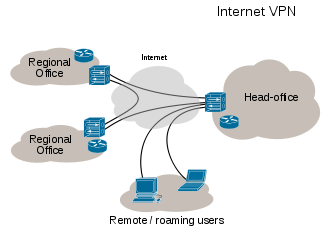The Interior Gateway Routing Protocol (IGRP) is a routing protocol to provide routing within an autonomous system (AS). In the mid-1980s, the most popular interior routing protocol was the Routing Information Protocol (RIP). Although RIP was quite useful forrouting within small- to moderate-sized, relatively homogeneous internetworks, its limits were being pushed by network growth.
The popularity of Cisco routers and the robustness of IGRP encouraged many organizations with large internetworks to replace RIP with IGRP. Cisco developed Enhanced IGRP in the early 1990s to improve the operating efficiency of IGRP.
IGRP is a distance vector Interior Gateway Protocol (IGP). Distance vector routing protocols mathematically compare routes using some measurement of distance. Distance vector routing protocols are often contrasted with link-state routing protocols, which send local connection information to all nodes in the internetwork.
To provide additional flexibility, IGRP permits multipath routing. Dual equal-bandwidth lines can run a single stream of traffic in round-robin fashion, with automatic switchover to the second line if one line goes down. Multiple paths can have unequal metrics yet still be valid multipath routes.
IGRP Protocol Characteristics:
IGRP is a distance-vector interior gateway protocol (IGP).
Distance-vector routing protocols call for each router to send all or a portion of its routing table in a routingupdate message at regular intervals to each of its neighboring routers. As routing information proliferates through the network, routers can calculate distances to all nodes within the internetwork.
Distance-vector routing protocols are often contrasted with link-state routing protocols, which send local connection information to all nodes in the internetwork.
To provide additional flexibility, IGRP permits multipath routing.
Dual equal-bandwidth lines can run a single stream of traffic in round-robin fashion, with automatic switchover to the second line if one line goes down. Also, multiple paths can be used even if the metrics for the paths are different. If, for example, one path is three times better than another because its metric is three times lower, the better path will be used three times as
often. Only routes with metrics that are within a certain range of the best route are used as multiple paths.
Configuration:
A very simple configuration of IGRP can be:
Router A
RouterA# conf t
RouterA(config)# interface eth0
RouterA(config-if)# ip address 70.0.0.1 255.0.0.0
RouterA(config-if)# exit
RouterA(config)# interface serial0
RouterA(config-if)# ip address 20.30.40.2 255.255.255.252
RouterA(config-if)# exit
RouterA(config)# router igrp 1
RouterA(config-router)# redistribute connected
RouterA(config-router)# network 20.0.0.0
RouterA(config-router)# network 70.0.0.0
RouterA(config-router)# network 71.0.0.0
Router B
RouterB# conf t
RouterB(config)# interface eth0
RouterB(config-if)# ip address 71.0.0.1 255.0.0.0
RouterB(config-if)# exit
RouterB(config)# interface serial0
RouterA(config-if)# ip address 20.30.40.1 255.255.255.252
RouterA(config-if)# exit
RouterA(config)# router igrp 1
RouterA(config-router)# redistribute connected
RouterA(config-router)# network 20.0.0.0
RouterA(config-router)# network 70.0.0.0
RouterA(config-router)# network 71.0.0.0
The popularity of Cisco routers and the robustness of IGRP encouraged many organizations with large internetworks to replace RIP with IGRP. Cisco developed Enhanced IGRP in the early 1990s to improve the operating efficiency of IGRP.
IGRP is a distance vector Interior Gateway Protocol (IGP). Distance vector routing protocols mathematically compare routes using some measurement of distance. Distance vector routing protocols are often contrasted with link-state routing protocols, which send local connection information to all nodes in the internetwork.
To provide additional flexibility, IGRP permits multipath routing. Dual equal-bandwidth lines can run a single stream of traffic in round-robin fashion, with automatic switchover to the second line if one line goes down. Multiple paths can have unequal metrics yet still be valid multipath routes.
IGRP Protocol Characteristics:
IGRP is a distance-vector interior gateway protocol (IGP).
Distance-vector routing protocols call for each router to send all or a portion of its routing table in a routingupdate message at regular intervals to each of its neighboring routers. As routing information proliferates through the network, routers can calculate distances to all nodes within the internetwork.
Distance-vector routing protocols are often contrasted with link-state routing protocols, which send local connection information to all nodes in the internetwork.
To provide additional flexibility, IGRP permits multipath routing.
Dual equal-bandwidth lines can run a single stream of traffic in round-robin fashion, with automatic switchover to the second line if one line goes down. Also, multiple paths can be used even if the metrics for the paths are different. If, for example, one path is three times better than another because its metric is three times lower, the better path will be used three times as
often. Only routes with metrics that are within a certain range of the best route are used as multiple paths.
Configuration:
A very simple configuration of IGRP can be:
Router A
RouterA# conf t
RouterA(config)# interface eth0
RouterA(config-if)# ip address 70.0.0.1 255.0.0.0
RouterA(config-if)# exit
RouterA(config)# interface serial0
RouterA(config-if)# ip address 20.30.40.2 255.255.255.252
RouterA(config-if)# exit
RouterA(config)# router igrp 1
RouterA(config-router)# redistribute connected
RouterA(config-router)# network 20.0.0.0
RouterA(config-router)# network 70.0.0.0
RouterA(config-router)# network 71.0.0.0
Router B
RouterB# conf t
RouterB(config)# interface eth0
RouterB(config-if)# ip address 71.0.0.1 255.0.0.0
RouterB(config-if)# exit
RouterB(config)# interface serial0
RouterA(config-if)# ip address 20.30.40.1 255.255.255.252
RouterA(config-if)# exit
RouterA(config)# router igrp 1
RouterA(config-router)# redistribute connected
RouterA(config-router)# network 20.0.0.0
RouterA(config-router)# network 70.0.0.0
RouterA(config-router)# network 71.0.0.0





0 comments:
Post a Comment